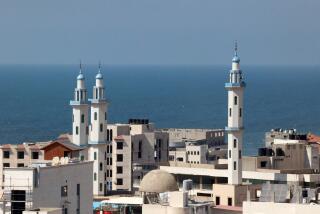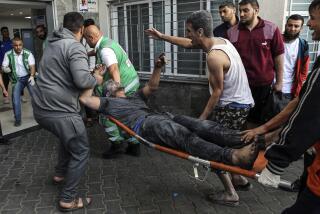Soviet Expansion in the Third World: AFGHANISTAN, A CASE STUDY by Nasir Shansab (Bartleby: $15.95; 216 pp.)
- Share via
This penetrating study might more aptly have been titled Superpower Expansion in the Third World: Afghanistan, a Cautionary Tale. Its author, Nasir Shansab, an Afghan businessman and social critic, now lives in the United States, having been forced into exile in 1975. He offers, first, an account of Afghanistan’s recent history, then sets that in the context of upheaval taking place from Iran to Nicaragua.
Shansab’s thesis is simple if not elegant: “In order to survive, social order must make sense to the people. It must be perceived as just, and it must offer security. Social systems . . . that fail to offer hope for a better future simply will not be endured passively for long,” he writes. “Time will inevitably and inexorably work toward violent change if negotiated reform does not take place.”
In Afghanistan, this rule might be applied equally to the Marxist governments preceding the Soviet invasion and to the monarchy that came to an end in 1973.
For 200 years, Afghanistan’s politics were shaped by the reigning superpowers of southwest Asia: Russia and the British Raj. After the British left India in 1947, the Soviet Union moved to fill the power vacuum. In the ‘50s, when the United States refused Afghanistan both military assistance and support for a crucial U.N. agreement that would have given the landlocked country badly needed transit routes, the Soviets granted Afghanistan a $100 million loan and initiated a series of barter exchanges and development projects that enabled them, eventually, to gain substantial control of the Afghan bureaucracy and military.
At the same time, the Royal Family and their appointees in government allowed official corruption and nepotism to flourish, according to Shansab. Clearly, he is of that world and he is unsparing of it. Little or nothing was done, he says, to bring rural Afghanistan into the 20th Century, and the chasm between the capital city and the provinces became an abyss.
Yet, as De Tocqueville prescribed, revolution came not from the “peasants” but from newly educated city dwellers shut out of the circle of privilege. And government repression made the growing left seem all the more attractive.
By 1973, the Royal House sought to survive by stage-managing a coup, in conjunction with leftist leaders, that installed the King’s cousin and brother-in-law, Mohammad Daoud Khan, as president of the first Islamic Republic of Afghanistan. Five years later, when Daoud turned from the Soviet Union toward the Islamic bloc for aid, the leftists, through Daoud’s own incompetence, were able to take power. They then tried to make up for decades of neglect by ramming through social programs (of literacy, marriage and land reform, etc.) that ran counter to Islamic law, ancient custom, and the vested interests of the all-powerful mullahs in the countryside. Uprisings multiplied and the invasion followed.
Here, Shansab fails to explore two factors that may have spurred the invasion. There is evidence to suggest the Soviets anticipated a major U.S. military response to the Iranian hostage crisis and wanted control of Afghanistan’s Shindand air base near the Iranian border for leverage in that event. And while they are no doubt interested in close access to warm-water ports, they are also surely threatened by the spread of Islamic fundamentalism, given the skyrocketing birthrate in their Islamic southern republics bordering Iran and Afghanistan (by the year 2000, there will be more Muslims than Russians in the Soviet).
Far from subduing the country, however, the invasion ignited the most heroic resistance movement of our time. The brutality of the Soviet war in Afghanistan has been matched only by its spectacular failure. Incredibly, as Shansab details, not a single major military offensive or pacification program has succeeded. The Red Army has only gained control of the larger cities, most of which now lie in ruins. Sabotage and defections in what remains of the Afghan army has been a steady source of arms and support for the mujahedin.
But the devastation inflicted on the country is reaching genocidal proportions. After eight years of fighting, 6.5 million Afghans--nearly half the population--are dead or in exile. There are more refugees from Afghanistan than any other country in the world, most living in 350 camps along Pakistan’s North West Frontier.
It is a war of scorched earth and attrition. Carpet bombing has destroyed crops and irrigation for Afghanistan’s precious arable land. Wells have been deliberately poisoned and livestock slaughtered. The result: induced famine, malnutrition and disease. Worst of all, the horrific injuries, particularly to children who have the bad sense to pick up explosive devices designed to look like toys.
The Russians may want to get out of Afghanistan now, if a compromise government can be formed, but as Shansab points out, the resistance is so fragmented that any coalition is unlikely to hold, as evidenced by the fact that the 10 rebel groups in Peshawar have been unwilling to pool their resources thus far. Further, he explains that the war has itself profoundly affected Afghan cultural mores: “Entrenched patterns of loyalty are being abandoned. Battlefield efficiency, political acumen, and leadership capabilities under stressful situations are pushing younger men into leadership positions that were traditionally reserved for the elders, the elite families, and the landlords.” Shansab says that this war-hardened younger generation is “not inclined to permit their former rules to again decide their destinies.”
He also draws a clear distinction between the “traditionalist” Islamic leaders who represent the old power structure, and the “fundamentalist” groups that cut across tribal and regional boundaries and that apparently are attracting a majority of both educated young people and military defectors.
Mutual suspicion, graft, and a lack of broad-based strategy have prevented the resistance from translating its considerable military success into meaningful political gain, and “the resistance leadership has largely remained outside of the international political process dealing with the Afghan crisis” including the “proximity” talks between Afghanistan and Pakistan. According to Shansab, they view the U.N.-sponsored negotiations as against their interests and not legitimate.
Reportedly, the United States is encouraging Pakistan to deliver more arms to the traditionalist groups than to the fundamentalists who are perceived as less moderate. And Shansab acknowledges that Islam, as interpreted today, impedes the very reforms that have long been needed. But in the brilliant closing section of this book, he traces the rise in fundamentalism in the Middle East to post-World-War-II modernization carried out on Western models that concentrated power, competency and economic resources in the hands of a small Western-educated elite, who sought above all to preserve their own status and privilege and so resisted any attempt at reforms.
Thus, “emerging political patterns in the Third World rather than serving the indigenous population, actually better aided the emerging global system.” Moreover, he argues that Western (technological) systems employed as management tools--in the absence of democratic principles and an independent judiciary--have chiefly bolstered dictatorships and destroyed traditional social forms without supplying any other protective net. Religion, he says, was the last refuge where people could express their own cultural aspirations.
Shansab delineates the repeated failure of U.S. diplomacy to recognize and support authentic popular movements, relying instead on strong men (the shah, Somoza, Marcos) to maintain regional security. But, in a vicious circle, extreme repression begets extreme opposition, eroding the moderate base the White House claims to favor.
He faults the United States also for relying on a nuclear deterrent to war, over conventional forces that could project power into regional conflicts. World War I, he reminds us, began with a single assassination. And if the Soviets are able to keep a significant military presence in Afghanistan, it will work to destabilize pro-Western Pakistan and apply enormous pressure throughout the Middle East.
One wishes Shansab’s prose were more accessible here, because his analysis should be understood by everyone above the age of reason. The tragedy of Afghanistan illuminates tensions at work around the world today, and the issues he explicates are crucial.
Shansab leaves us with the hope that the growth of the Afghan resistance will give other countries in the region time--and motivation--to reform their institutions and “regain their inner national strength to withstand the dangers of Communist penetration of their societies.”
Whether they will meet this challenge remains to be seen.
More to Read
Sign up for Essential California
The most important California stories and recommendations in your inbox every morning.
You may occasionally receive promotional content from the Los Angeles Times.













